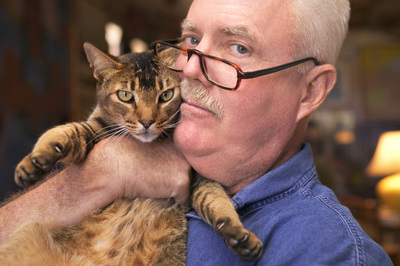Animal Lovers
There are more pets than children in American households. For many people, old and young alike, pets are as much a part of their family as any human. Only legally enforceable documents can guarantee a pet’s secure future. Reasons such as allergies, conflict with other pets, and exclusion of pets from rental apartments, and promises made by friends and family to care for your pets often fail. From a legal standpoint, pets are classified as property. Although, to their owners pets often mean more than the couch or the desk, they are best friends, companions, and family. When a person begins the estate planning process and classifies property and beneficiaries, the pets must be addressed as well. Americans are very concerned about providing continuing care for their dearly loved pets. Sadly, a considerable number of domestic pets are unwittingly condemned to imprisonment and a life without love because their owners did not know—and were not well advised—to make arrangements for them.
The idea of legally enforceable documents that ensure companion animals’ continuing care is relatively new.
The District of Columbia, Maryland and Virginia all adopted the Uniform Trust Code provisions addressing Trusts for the Care of an Animal. All three jurisdictions adopted the same provisions with Virginia adding extra provisions. Statutory provisions authorize easy establishment of either an inter vivos or testamentary pet trust.
(D.C. Code 19.1-1304-.08, MD Est. & Trusts 14-112, VA Code 55-544.08, Unif. Trust Code 408).
Wills. The belief that pets can be adequately protected if they are mentioned in a will is a myth. Consider the following pitfalls of a will:
- Instructions in a will are written in invisible ink; that is, instructions in a will are not enforceable. Wills disburse property: "Bob gets the house and dog." Wills cannot enforce demands that every year Bob paint the house he now owns. Nor must Bob care for the dog.
- Wills are not enacted immediately. There will be a waiting period before the will is read and the property changes hands. Ask yourself who owns and cares for the pet before the will is probated? Where will the pet be held during this waiting period? And if legal disputes arise, the final settlement of property can be prolonged even further.
- Wills do not allow disbursement over a pet’s lifetime. In a will, the owner cannot distribute funds over time, which can be achieved with a free-standing traditional pet trust or pet protection agreement.
- Changes to the will are in the court’s discretion. Who do you want deciding the fate of your clients’ pets?
- Wills make no provisions for incapacity. A will cannot address the possibility that the pet may need to be cared for during the owner’s lifetime.
- Pet provisions in a will may be “honorary.” Forty states and the District of Columbia recognize statutory pet trusts; in these jurisdictions, pet owners who include a simple directive in their will (e.g., “I leave my dog Rascal and $5,000 for his care to my friend Bob”) can be assured that the funds and pet will remain together. In the ten states without statutory pet trusts, however, these provisions are “honorary.” The person who receives the funds decides whether or not to use them for the pet’s care. There is nothing to prohibit the “trustee” from dumping the pet at the pound and using the money to go to Paris.
Pet trusts. Unlike a simple directive in a will, a pet trust provides a host of additional protections and advantages:
- Pet trusts are valid during the pet owner’s life and after his death.
- Pet trusts can help preempt problems with substantial and involved estates. Pet trusts are particularly useful if the client expects a contest to the estate—for example, if the amount left for the pet’s care is enough that someone will contest the client’s capacity, or if there is a litigious family member whom the pet owner believes may dispute the final documents.
- Pet trusts and pet protection agreements control the disbursement of funds.
- Pet trusts allow for an investment trustee. A trust protector (separate from the pet guardian or trustee) can be appointed to invest funds with a view toward growth of the principal and future use on behalf of the pet, heirs, and charitable recipients.
- Pet trusts and pet protection agreements allow provisions for incapacity. Pet trusts and pet protection agreements can ensure that the owner and pets will remain together in the event that your client moves to a nursing home or other long-term care facility. Studies have shown that seniors and those with health issues receive increasing benefits from their pets—lower blood pressure, increased exercise and circulation, reduced anxiety and stress, boosted mental acuity, enhanced opportunities for social interaction, and decreased loneliness. The New York Times has reported that nursing home residents live longer when a pet is present. With a pet trust or pet protection agreement, owners may even leave a portion of the funds remaining after the pet’s death to the facilities that kept the owner and pet together.
The pet protection agreement can be completed with or without a lawyer’s help. Any trusted advisor (such as an accountant, trustee, insurance representative, investment advisor, lawyer, or paralegal) can help a client complete this document. Like the pet trust, the pet protection agreement is valid during the owner’s lifetime as well as after the pet owner’s death. Unlike a pet trust, however, a pet protection agreement cannot ensure that owner and pets will remain together in a long-term care facility.
Pet guardian. The pet guardian can be a person or an organization. The pet guardian will keep the pets, generally in the guardian’s home, and must carry out the pet owner’s instructions. If a pet organization assumes this role, the document should include directions about adoption.
Ideally, there should always be a successor pet guardian selected to ensure care if the pet guardian is unwilling or unable to assume care for the surviving pet. Ultimately, the concern is that the pet will always be cared for. In case the pet outlives or otherwise does not have a pet guardian, a shelter, sanctuary, or breed rescue of “last resort” should be named. Usually, shelters and sanctuaries require a fee, and this must be factored into the consideration of how much money to leave.
Funding. Although funding is optional, it is recommended. Funds can be a fixed amount or a percentage of an insurance policy, bank account, 401(k), or even a portion of the sale of a home. Other options include transferring cash, securities, bonds, real estate or other property to an inter vivos trust to fund it. The income from your investments will be used for your animals when the time comes, and if it is not enough to accomplish what needs to be done, then the investments will be sold to provide needed cash.
Many factors should be considered when deciding how much to leave for a pet’s care, not the least of which is the fact that pets are more expensive as they age. Some things to consider are:
- How many pets are included?
- What type of pets are they?
- How long are they expected to live?
- Does the pet guardian need funds to keep the pets in the manner to which they are accustomed?
- Is the pet guardian going to be compensated from the remaining funds after the pets pass, or should the pet guardian receive monthly or yearly compensation?
Remainder beneficiaries. Most people incorrectly believe that all of the funds must be spent on the pet. This is not true. As a matter of fact, it is vitally important to direct the distribution of all funds remaining in the documents so that the court doesn’t get involved in doing this. The majority of pet owners leave the remaining funds after the pets’ death to animal charities and family. It is important that the remainder is left in percentages as opposed to whole numbers; you never know what the final number may be.
Pet’s detailed description. Identifying the pet in detail is critically important to prevent a pet guardian from replacing the original pet in order to illegally extend trust distributions or benefits.
Instructions for care. Instructions regarding the pet’s care should be as detailed as instructions that a parent might provide when leaving a baby in a sitter’s care for an extended period. Detailed instructions help ease the transition between pet owner and pet guardian. However, the instructions should allow the pet guardian to exercise some discretion when facing new circumstances.
Keeping pets together. If the pet owner wants to keep together certain pets because they were raised together or have otherwise bonded, make sure to include this instruction in the document; it will not happen automatically. The ability to keep pets together can have a significant impact on the choice of pet guardians .
Including all present and future pets. All pets owned by the pet owner, including those the pet owner does not yet have at the time the documents are written, should be included. It saves the effort of having to formally amend or create a new document every time a pet dies or a new one comes into the family. Including the term “all my pets” accomplishes this.
David Taylor
621 G Street, SE
Washington, D.C. 20003
202.546.1536
621 G Street, SE
Washington, D.C. 20003
202.546.1536


